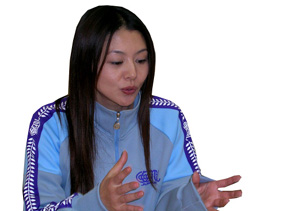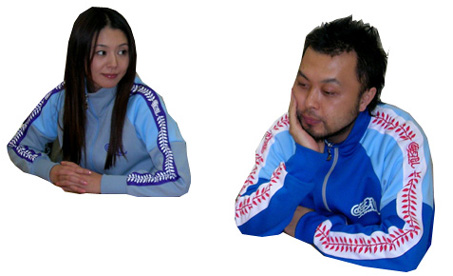ASA-CHANG & JUNRAY FEAT. KYOKO KOIZUMI
PEOPLEText: Yasuharu Motomiya
You’ve said that the ultimate form of ballads is enka, but this track felt closer to traditional folk or nursery rhymes to me. Like the poetic pillow song “Tsukibune”, what are the reasons for your interest in traditional Japanese culture?
A: I wouldn’t call it an interest, as such. I’ve grown up watching old music TV programs like “The Best 10” and Japanese music is what I hear the most; this can’t be denied. I’m not rejecting Western music, but it just feels unnatural for me to work within it. I wasn’t aiming specifically for something, but the sound simply became Junray.

K: We may be the last of a generation that had a Western-music-complex. There was a time when it was cool to criticise Japanese music, but things have moved on since then and there’ been a shift of interest to the opposite direction. To things ingrained in ourselves, the environment we grew up in. They’re a part of a Japan that I like.
A: And in your twenties, you start playing roots music like ska because that’s what seems cool. Well, we’ve gone past that stage too, and its now impossible to just imitate others.
In that case, are you always aware of creating a new kind of future for music?
A: I don’t know if it’s a future or a past, but it is definitely my own present. They are the results of realising, in sounds and visuals, the thoughts I have now, and in this case, I needed Koizumi-san in order to do so.
Koizumi-san, do you also have an interest in Japanese culture?
K: Two ends exist together. Being brought up by parents born in the early-Showa-era, following the good old ways of Japan, whilst at the same time being able to get hold of new technology whenever its there – both go for me. Junray brings together these elements as one. I like kimonos, I like fashion from outside.

Listening to Junray, I can feel modern technology’s hyper side and the spirit of Japan at the same time.
A: Yeah, it does come out like that. They’re things that can’t be mixed intentionally.
K: That’s true. If you tried to create that, it’ll probably end up as something repulsively artificial.
A: Exactly. I think it became the way it is because it’s not a mixture, but something that came from the roots. That’s why it sounds like nothing ever heard before.
Can you tell us about any art forms or artists that have caught your attention recently, or what music you’re listening to?
K: It’s a little similar to kimono, but I’m quite into Japanese art, like Yuki Ogura, who I went to see a couple of years ago, or Seiju Omoda. It’s actually pop-art. Some are quite eerie, but others are quite cute, like a woman having a bath. This particular piece came on TV once but I missed whom it was by. Then a friend called and told me about a sweet exhibition that was going on, and the picture of the woman having a bath was exhibited there. Since then, I’ve been to see quite a few. I listen to a lot of music, but there’s no single one that stands out right now.
A: I’m also not the type to listen to music intensely. At home, not a all. I’ve always been like that, and as a listener, I must be one of the worst (laughs). It’s not that I shut it out, but I just don’t feel like it after spending a whole day with music. So I don’t know as much as say a DJ does. What’s interesting me now is how well contemporary dance suites the Junray sound. Contemporary dancers are using “Hana” like crazy, I can’t tell you how many enquiries I’ve had about dance groups using “Hana”. It seems to be a good track to dance to.
K: I can kind of imagine.
A: This trend basically lead to me directing the music for a dance company called Idevian Crew. The Tokyo performance just finished, and I think they’re now touring New York and Canada.
K: The PV for “Senaka” was really cute, too.
A: Yeah, that was dance too. She wasn’t from Idevian Crew, but the whole PV is just dancing, with no effects or anything.
K: A normal girl sits on a chair and dances all the way through. It was sexy and melancholic and sweet.
A: Nowadays you need only a pinch of filmed material to process over and over again into a film, so the director and I wanted to do the opposite, of just a girl dancing. But the result was really good.
Why have you chosen music as your means of expression?
A: I agree it’s been a strange road so far, because I was drawn to music unintentionally in the first place. I quit Ska-Para in 1993 because it was getting too busy for me to carry on with my hair and make-up work, but then carried on as a session player or support, and in 1998 started Junray. The sound of Junray was already there by then, so the music came onto the sheets easily. My head was filled with sounds and I couldn’t stop writing.
Those rhythms play in your head?
A: They do. It’s much easier to have the music on sheets though when you’re trying to get it across to the band members. I know that it will come out exactly as I want it then. Even the parts that come out as noise are specified; that’s why the random-sounding parts are still in line. Everything is calculated so that the scene can be expressed.
Koizumi-san, you also work as an actress. Does the art of singing have anything in common with the art of acting?
K: There’s not that much difference. I didn’t begin by wanting to sing, or to act, but with the simpler thoughts of wanting to make people happy or to entertain, and to become someone with the power to do so. Whether that’s through acting or singing, it doesn’t make that much difference to me. Having said that, I guess singing is more fun. I think filming is more for the director; as an actor what’s important is to respond to and understand the needs of the director. Singing is a little more liberating.
Were you liberated in some way by this recording?
K: I did feel liberated when the whole thing was finished. Whilst I’m singing, I just sing this track that I have been given. I’m not really aware of how the music is Junray, or where the track is heading towards – it’s too difficult to imagine concretely. But when the song was completed the results exceeded what I had imagined, and I felt really liberated from that.
A: When we took Koizumi-san’s vocals, we just made a simple track. For the final song, we break that down and build it up again, so she couldn’t know how it would end up – she had to trust us. I didn’t feel like I couldn’t edit her vocals, or compromise the Junray sound – I think that would have been disrespectful. So that’s how that piece became what it is.
I thought that this collaboration was revolutionary. Until now, people like my mother didn’t have the chance to hear music like Asa-chang & Junray, but Koizumi-san’s involvement means that that’s been broadened a lot.
K: My mother liked it.
A: Really? That’s amazing!
K: I was listening to it and she asked, “What’s this?” I told her it was the track I did with Asa-chang and she said, “I like it.”
A: Amazing!
K: You’ve met her before.
A: Have I? I’ve seen a picture of her when she was young. (laughs)
K: We’ve met each other’s moms. (laughs)
Read more ...




